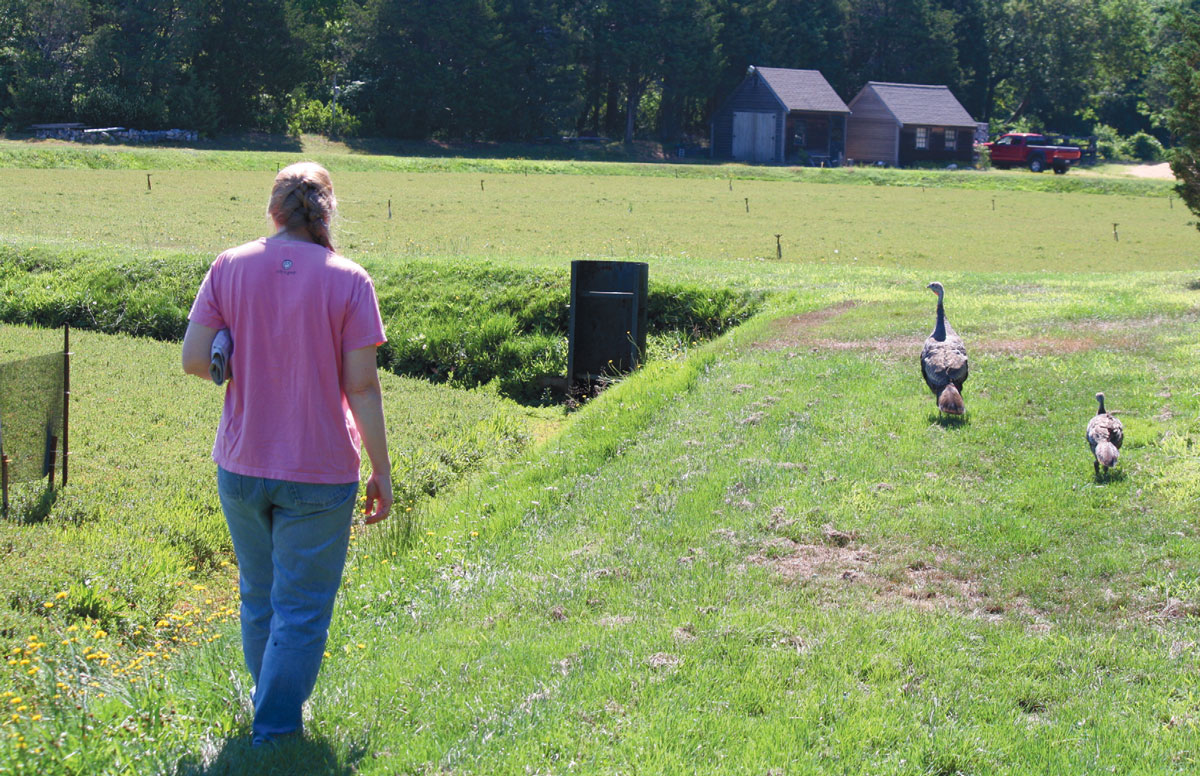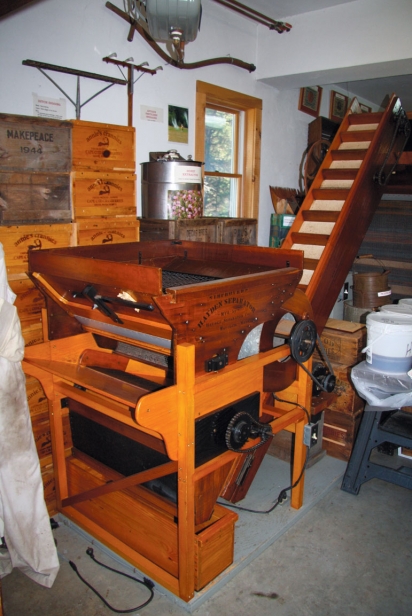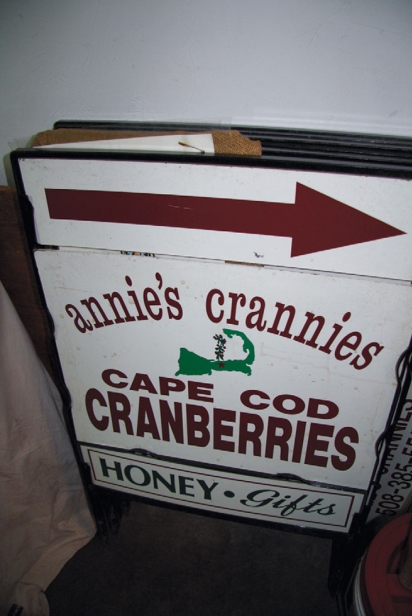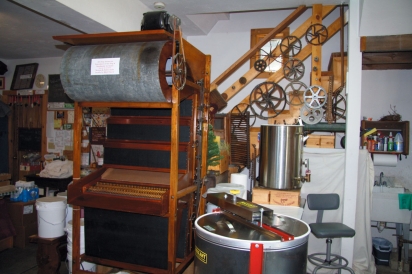Trodding the Bogs: Annie’s Crannies
“Mother Nature is a lot like a Broadway show,” Annie Walker says while standing amidst the tools of her trade. Where once there were sewing machines, drawstring re-threaders and leather paint, there is now a collection of antique cranberry wet shovels, screen boats and separators.
“At 8:05, the curtain goes up whether you’re ready or not.” The growing season marches on towards its own “curtain-up” at harvest time, and Walker is one who would uniquely know the similarities of mounting a Broadway show and running a Cape Cod cranberry operation. After working for over 25 years and on 52 shows as a production wardrobe supervisor, Annie left the Great White Way to take over the very same cranberry bogs her grandfather once owned in Dennis.
The cranberry is a wild and native fruit of Cape Cod, and this year marks the 200th anniversary of the cultivated cranberry that happened quite by accident in Dennis back in 1816. Henry Hall cut down the trees bordering his cranberry bog to use as firewood. A storm blew in and deposited nearby sand that covered over his bog. Thinking everything was ruined, Hall was stunned to see the next year’s crop not only survived, but increased.
Sanding a bog turns out to be beneficial in two ways: the sand stimulates new growth of the cranberry vines and smothers fungal spores and the eggs of pests that would otherwise hatch in the spring. It was shortly thereafter that the ship building industry slowed and ship builders and sea captains turned to the budding industry for their career transition. Local coopers, whose demand waned as well, for the same reasons, also pivoted to the cranberry growers and supplied them with barrels for storage and shipment. A barrel (100 pounds) is still the unit of measure in use today for cranberries.
Born and raised in Dennis, Annie long knew of her family’s deep-rooted ties to the cranberry industry, however dormant they had gone. Annie’s grandfather, Benjamin, was a lobster fisherman as well as cranberry farmer who went on to purchase the bogs he was working on back in 1911. Benjamin toiled through ever-leaner years as the cranberry industry withered. Finally in 1959, he sold his last remaining bog and died the next year.
The bogs sat quiet for over thirty years. Nature crept in and reclaimed the once cultivated land. Wild blueberry bushes took over where once were cranberries…until the day that Annie decided to try to restore the bogs and continue the family tradition as a cranberry farmer. After researching what became of Ol’ Ben’s bogs and negotiating a price to buy it back, Annie’s Crannies was born in 1995.
Her career in show business got its start years earlier right in town at the Dennis Playhouse, but she had had enough. “I was just done,” she says of her former life working on large productions not only on Broadway, but also at Madison Square Garden and Lincoln Center. There was a time when Walker tried to straddle both worlds. “Ugh, I’d be out on the bog, and the Garden would call with the stupidest questions! Every little thing, all day long,” she chuckles. “I finally told them to collect all their questions and call me once at the end of the day.”
Gone are the headaches (now replaced by backaches) associated with managing a staff and a budget of up to $11 million for a show. “I’d have to figure out what it would cost for a production to get it to opening night, get it to the Tonys and what it would cost for a five-year run,” she remembers. “And that’s what I was known for. I could get the costs to within $100 of budget.” She goes on, “I come out here and charge $5 for a jar of my honey only to find out it had been costing me $5.25 to produce!” howls Annie of one of the many other products she sells under the Annie’s Crannies label. Her brother, Danny, has since taken over the books.
“I wanted to continue the agricultural history,” Annie states. “The industry started here in Dennis, and I wanted to try and protect it for future generations.” Indeed, she did not get into this business for the money. “You don’t get rich doing this,” she laughs. “You just hope you break even!”
Due to a collapse in the juice market, cranberries that were fetching prices of $90 to $100 a barrel in the 1990s now are going for a mere $30. “That’s the price they were getting a hundred years ago!” Annie cries.
This explains the expanded line of Annie’s Crannies products and also how the once 1000 acres of cranberry bogs that used to exist in Dennis are now down to just nine acres: Annie’s three working bogs, another down the street that’s run by her husband, Dean Emery, and a fourth bog on the property she never took back from nature that serves as an important sanctuary for area wildlife.
Annie grows the Howes variety of cranberry. Developed by Eli and James Paine Howes on Scargo Lake in Dennis back in 1843, the Howes cranberry is only grown in Massachusetts. It ripens later in the season (just in time for Thanksgiving) and is more rot resistant than others so it stays fresher longer. Annie and her crew of family and friends dry harvest the berries, unlike the vast majority of growers who wet harvest with the familiar scene of a flooded bog and the vibrant red berries corralled for collection. Only five percent of farmers dry harvest, and it’s those berries that are used for fresh fruit. Wet-harvested cranberries are destined to become juice.
Once gathered, the cranberries are run through antique separators that have been lovingly restored by Dean. They look as though they should be in a museum, but they are put through their paces every fall, separating out the berries by the level of bounce in them…the bigger the bounce, the better the berry. It’s the same technique and, in this case, the same machinery that has been used for well over a hundred years.
As if dry harvesting isn’t challenging enough, Annie strives to produce the finest fruit in the healthiest way. Annie’s Crannies is U.S.D.A. GAP (Good Agricultural Practices) certified and subscribes to the I.P.M. method of farming. I.P.M., or Integrated Pest Management, is a program that strives to suppress pest levels to below that which would impact the bottom line but not to a point of eradication. Sanding the bog in winter, the existence of birdhouses along the bogs to introduce natural predators, and traps all help to control the pest population without the heavy use of pesticide spraying with its detrimental side effects. As Annie says, “We all have our place in this world.”
It’s not just the berries, but the wildlife that she protects from the pesticides. It is a veritable migratory crossroads at the bogs. A mother deer and her two fawns, a family of turkeys, ducks, foxes, coyotes, hawks and Annie’s bees, that number in the six figures, all use the bogs. Whether as hunting, feeding or mating grounds or simply as a cut-through on the daily commute, the animals rely on the bogs a great deal.
In addition to the cranberries, Annie’s Crannies does have a line of other products for sale when the season rolls around: bog side honey, beeswax candles of all shapes and sizes, honey and beeswax soap along with jams, cranberry recipes and gift boxes (crafted by her stepson Matt Emery) are available during harvest season. It truly is a year-round venture to prepare for the exceedingly short window of five weekends that Annie’s Crannies is open for business.
“Every month, something gets done,” Annie says. “I do all my printing of labels in January. I make the repairs to the hives in February.” In August, it’s time to make the soap and bottle the honey and, after the annual family Labor Day party, September is all about the organization for the season that opens on Columbus Day weekend and runs through the next four weekends. What happens if the end of the month comes along and a particular task isn’t completed? “It doesn’t get done,” Annie states matter-of-factly. “You’ve got to stay on schedule, even if it means you don’t have as much of a product as you would have liked to have made.” There’s no question she could always use more products. She sells out every year of everything before the end of the season.
It all started with a fateful visit from a local garden club that launched the Annie’s Crannies product line. “The Dennis Farmers’ Club came by for a tour and wanted some cranberries,” Annie recalls. “The next year, they were looking for other things to purchase as well.” More than 20 years later, you need to mark your calendars to get to Annie’s Crannies early in the season. Otherwise, you’ll be out of luck.
Annie recalls one visitor’s attempt at a helpful suggestion. “She said, ‘you should advertise to let more people know you’re here.’” Another hearty Walker laugh at the memory. “I told her I sell out of everything anyway! Plus, isn’t there something nice about stumbling onto this hidden gem?”
There’s always a heightened sense of delight when one discovers something, whether it’s a restaurant, farm stand, hiking trail or beach, that seems to be known only to a select few; a spot which has yet to be swarmed upon by the masses. In the case of Annie’s Crannies, it’d be a heck of a stumble to find by accident. The barn and bogs are located on a side street of a side street off a side street of Route 6A in Dennis. The driveway is not much more that a dirt path cut into an otherwise continuous stand of trees. It’s easy to miss and to drive right by (OK…twice). Thankfully, Annie puts out roadside signs when the season rolls around.
“On Broadway, the audience is your boss,” Annie says. “Out here Mother Nature is, and she’s a good boss. She sees when you’re tired and need a day off so she’ll send a big storm through every now and then.” Like with all farmers, the days are long and the work is arduous. Annie’s day starts at two in the morning to avoid the midday heat throughout the summer months. Asked when she works until, Annie smiles, “Exhaustion.”
The deep sigh and flyaway hairs escaping her ponytail tell of a day, and of a life, that is not for the faint of heart, mind or body. However, the bounce in her step and smile on her face express a life that she wouldn’t trade for all the Tonys in the world.
Annie’s Crannies
anniescrannies.com










